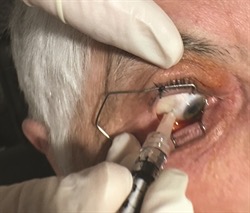Intravitreal Injection

The procedure is done in the office using topical or subconjunctival anesthesia. The ocular surface is treated with an antiseptic to reduce the risk of infection. A lid speculum may be used to keep the eyelids open during the procedure. There is usually minimal pain from the injection. Following the injection, you may experience temporary decrease in vision, floaters, sensitivity to light and irritation which may last several hours. There may also be a red spot on the white part of the eye where the injection was given. Artificial tears are recommended to reduce these side effects. If you experience severe pain or loss of vision, you should call your doctor. A follow-up visit is scheduled in 4-6 weeks.